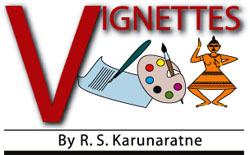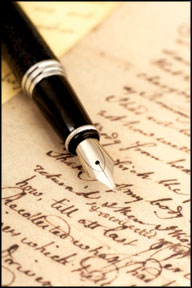
Value of fountain pen enhanced
The history of writing implements dates back to the Greek and Roman
periods. The first writing implement was the reed pen. This was replaced
by the quill pen after some time. As some of you may be aware, the quill
pen was made from the outer wing feather of birds such as the swan, the
goose or the crow. But the feathers of the turkey were preferred for
making the quill pen way back in the 6th century AD. Surprisingly, the
quill pen remained the principal writing implement for nearly 1,300
years.
People found it difficult to use the quill pen because it had to be
sharpened very often. As a result, the bronze pen came into being in the
6th century largely replacing the quill pen. However, the metal pen
became widespread only in the 19th century. The first patented steel pen
was made by the English engineer Bryan Donkin in 1803.
The considerable weight and the ugly shape of the steel pen prevented
it from becoming a practical writing implement. As a result, many
experiments were made to produce something more attractive and light in
weight. Thus Lewis Waterman (1837-1901) is credited with producing the
first practical pen. Waterman's fountain pen remained the chief writing
implement in the West until the introduction of the ball-point pen after
the World War II.
The ball-point pen became popular and remains so even today because
it is a cheap writing instrument that needs no ink filling or aftercare.
On the other hand, it could write on any surface and it was useful for
taking carbon copies. Today the ball-point pen remains the universal
writing implement.
With the mass production of cheap ball-point pens, you hardly see any
student using fountain pens today. The ball-point pen can be used and
thrown away. However, nobody seems to have thought of the environment
pollution created by the discarded ball point pens which are not
biodegradable. If you rummage through any garbage heap, you can easily
find hundreds of ball-point pens waiting to pollute the environment.
On the other hand, nobody in his right senses would throw away a
fountain pen even if it has ceased to serve any purpose. In fact, most
people collect old fountain pens as a hobby. Most of these pens had been
gifted by parents, teachers and well-wishers. So, each fountain pen has
some sentimental value attached to it.
The fountain pen is an ideal gift that can be given to a student who
gets through an examination or wins some award. It is also an ideal
birthday gift. This is one way of getting the new generation interested
in the fountain pen.
With the advent of new technology such as the Internet and E-mail,
many people do not write letters, articles and books using pens. The
techno-savvy new generation might laugh at a man using a fountain pen
because he is out of tune with the times.
 Personally
I feel that the fountain pen is not dead yet. Reputed companies still
manufacture fountain pens because there is a demand for them by writers.
The tragedy is that you are no longer able to buy those cheap fountain
pens in the open market. As a student, I used many brands of fountain
pens such as "Swan, Pilot and Dinky." But these pens are no longer
available. Most probably they are no longer produced. Personally
I feel that the fountain pen is not dead yet. Reputed companies still
manufacture fountain pens because there is a demand for them by writers.
The tragedy is that you are no longer able to buy those cheap fountain
pens in the open market. As a student, I used many brands of fountain
pens such as "Swan, Pilot and Dinky." But these pens are no longer
available. Most probably they are no longer produced.
Being a lover of fountain pens, I wanted to buy one of them recently.
I tried many reputed stationers but they had only ball-point pens. then
I visited a company that imports all kinds of writing instruments.
Although no pens were on display, they had all kinds of fountain pens
imported from the United Kingdom and the United States. However, an
average person cannot buy these fountain pens because they are very
expensive. The prices ranged from Rs. 2,000 to Rs. 6,000!
According to the manager of this shop, the fountain pen has become a
luxury item. He says there is an increased demand for them despite the
high prices. According to him, customers are also concerned with the
mechanics of the pens they buy. He is right because there was a time
when gold nibs were very much in demand.
Today expensive fountain pens are used by heads of States, Ministers,
company chairmen, executives and leading writers. Although we use the
ball-point pen because it is cheap and convenient, we do not have any
regard for it. If you begin to use a fountain pen it is something
personal and you will jealously guard it.
Most of us may not be able to buy Alfred Dunhill's Namiki pens which
are available in limited quantities. The prices are in the range of
50,000 Sterling Pounds. Once James Bond was honoured with a Dupont pen
in gunmetal with a laser-pointed bullet stored in the barrel! That was
something unique.
If you care for your handwriting, try to buy a good fountain pen. It
is a symbol of cultured life. |

